Monterey Bay National Marine Sanctuary (MBNMS) has once again partnered up with the Monterey Bay Aquarium Research Institute (MBARI) to conduct deep-sea research in MBNMS. Led by Chief Scientist Dr. Jim Barry, Dr. Andrew DeVogelaere (MBNMS Research Coordinator) and MBARI and MBNMS research staff will record observations and conduct experiments at various locations, at depths from 200 to over 3,000 meters, and will re-visit Sur Ridge, a place of incredible deep-sea coral and sponge assemblages. Of course, the extremely talented and accommodating R/V Western Flyer ROV pilots and the rest of the crew make every effort to assist the science team in achieving their research goals.
This webpage will serve as the unofficial blog for the five-day expedition.
Follow along on Twitter @MBNMS
Day 5 – Aug 28
Two quick dives were on the docket for the last day of this expedition. We launched at 0630 and took corals that we transplanted last night in refrigerated seawater. After placing them at a site at 840 meters on Sur Ridge, the ROV collected several species of coral. Once the ROV was secured on deck, the science crew quickly transplanted these fresh coral branches into their new man-made homes, all while never making contact with air. The ROV made a quick turn-around dive back to the bottom to place these transplants by their earlier counterparts. Future dives will determine the success, or lack thereof, of each treatment.

The remainder of the second dive was spent collecting animal specimens and observing fluorescent dye transport through sponges. Once on the surface, the science crew sprung to life once again to sort, identify, photograph and preserve specimens.
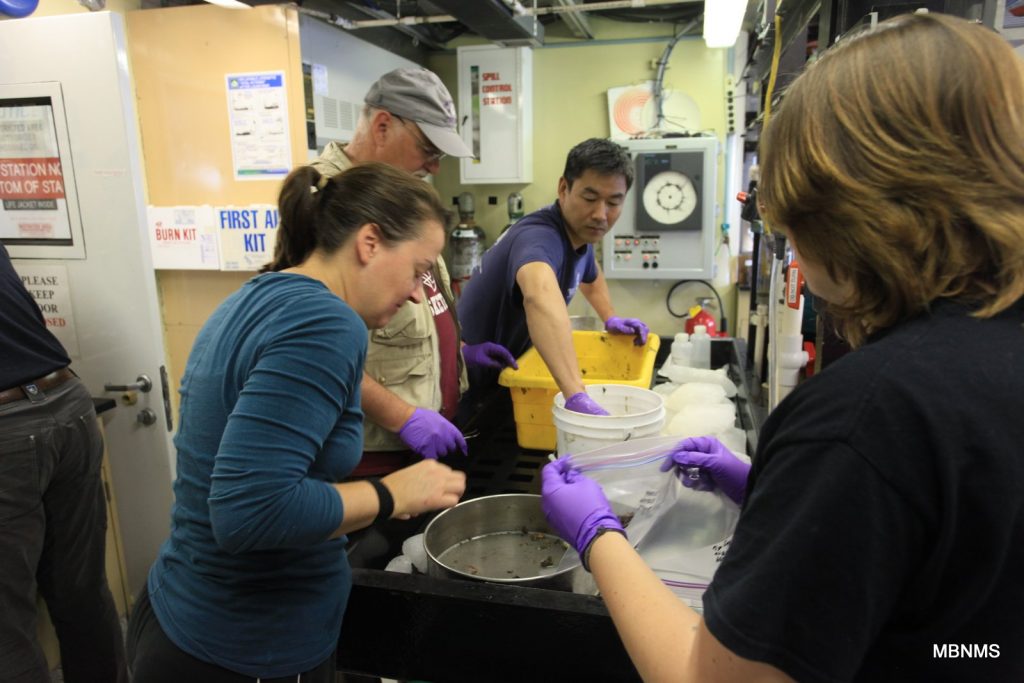
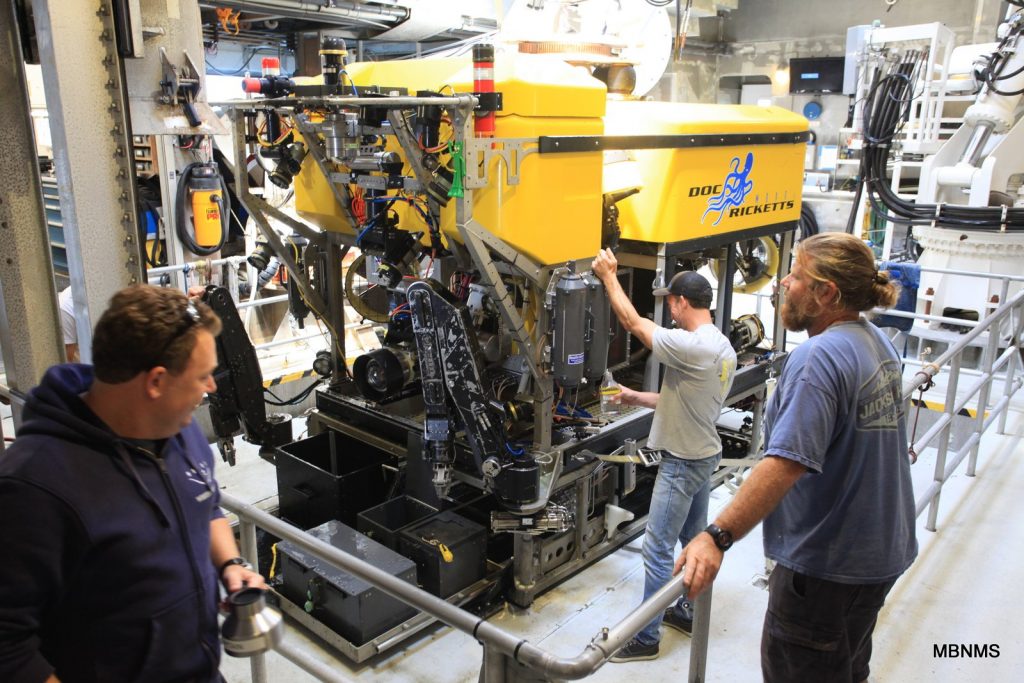
Blessed with optimal weather and an upbeat crew, this five-day research expedition was a ringing success. On behalf of Monterey Bay National Marine Sanctuary, I would like to thank Dr. Jim Barry for extending the invitation to join MBARI on this cruise, and for the tireless work of MBARI crew and pilots that always do everything within their power to accommodate our requests, both of the scientific and comfort nature.
Chad
Science Crew:
Jim Barry, PhD (MBARI)
Chris Lovera (MBARI)
Josh Lord, PhD (MBARI)
Charles Boch, PhD (MBARI)
Kakani Katija, PhD (MBARI)
Linda Kuhnz (MBARI)
Andrew DeVogelaere, PhD (MBNMS)
Chad King (MBNMS)
Erica Burton (MBNMS)
Jim Brennan (Marine Ecological Consulting Services)
Daryll Carson (Stanford undergrad)
Aug 27 – Day 4
Today’s first site was a larger assemblage of corals that Dr. Barry and his team transplanted in June at a depth of 840 meters at Sur Ridge. We were elated to see that most of them were alive and well! Preliminarily, this is a positive sign towards steps in developing a method for transplanting deep-sea corals, should a future crisis arise.

And then, probably the most humorous moment of the cruise happened:
We just shaved a deep sea sponge with a robot.
For science! pic.twitter.com/tapWcPdA6l
— Monterey Bay NMS (@MBNMS) August 27, 2016
Yes, we asked the ROV pilots to “shave” several sponges of debris along their tops so that we would get better readings . Definitely a first at MBARI.
Here's a video of a goiter sponge expelling the fluorescent dye pic.twitter.com/ehXlkJhqlj
— Monterey Bay NMS (@MBNMS) August 27, 2016
Currents were measured near corals with a special instrument called an ADCP, which stands for Acoustic Doppler Current Profiler. Essentially, it uses sound to measure currents using the Doppler Effect. Quick refresher: Let’s say a train is coming at you, blaring it’s horn. It has a relatively high pitch, but you don’t notice it until it passes you, and suddenly it lowers in pitch. Why? Because the sound waves coming at you from an oncoming train are compressed into a higher frequency because of the train’s speed and direction relative to you. When it passes you, the waves are further apart, making the sound a lower frequency. Well, the ADCP emits sound, which bounces off of particles in the water, and depending on the return frequency, it knows if the water is moving towards or away from the instrument. It uses a shift in these frequencies to calculate velocity. Since corals and sponges rely on water flow, it’s important to get an idea of what that flow and direction are like around Sur Ridge.
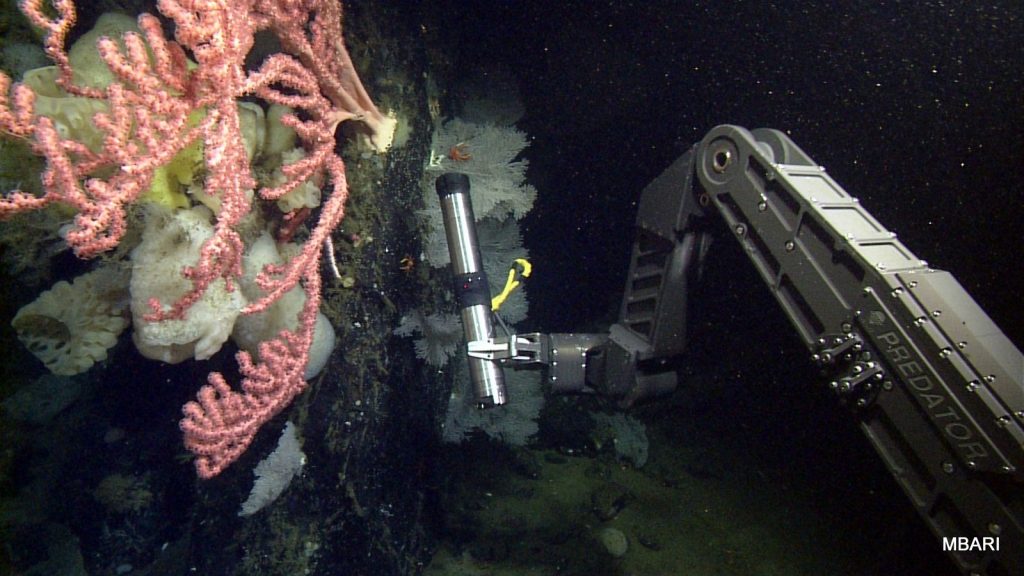
The ROV roamed up a 400 meter-high section of Sur Ridge during the afternoon, taking ADCP measurements and collecting various corals for tonight’s transplantation experiment. During this dive, most of the science team was busily making 20 new homes for the corals out of PVC, screws, nuts, and concrete. Ten corals will be transplanted tomorrow morning (after being kept overnight in refrigerated seawater), and ten more corals will be collected during tomorrow’s first dive, then brought up to the surface to be immediately transplanted and brought back down. The purpose of this is to compare mortality with the immediate and overnight methods.
Some of the science crew are preparing coral transplant containers. All we need is PVC, screws, bolts and concrete! pic.twitter.com/fV4g8cwvop
— Monterey Bay NMS (@MBNMS) August 27, 2016
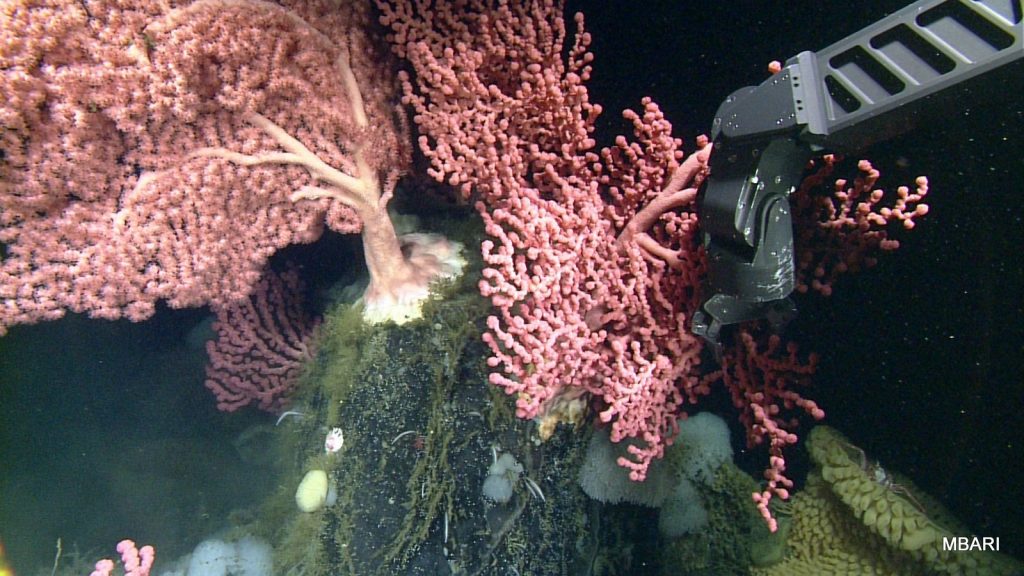
This crew is looking forward to concluding a successful research expedition tomorrow.
Chad
Aug 26 – Day 3
Sur Ridge.
We’re back!
Since discovering corals here in 2013, this spot has earned a place in our hearts, perhaps the “Little Davidson Seamount” that could. In fact, Sur Ridge is not a seamount, at least not in the oceanographic context. Still, it stands 450 meters tall, about the same height as Hecker Pass at Mt. Madonna, for you local Bay Area people.
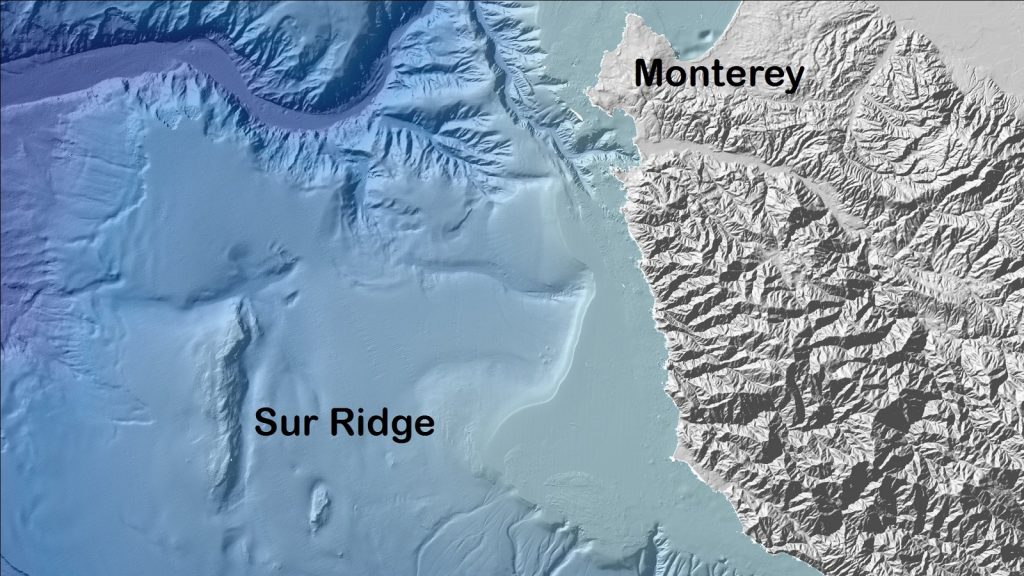
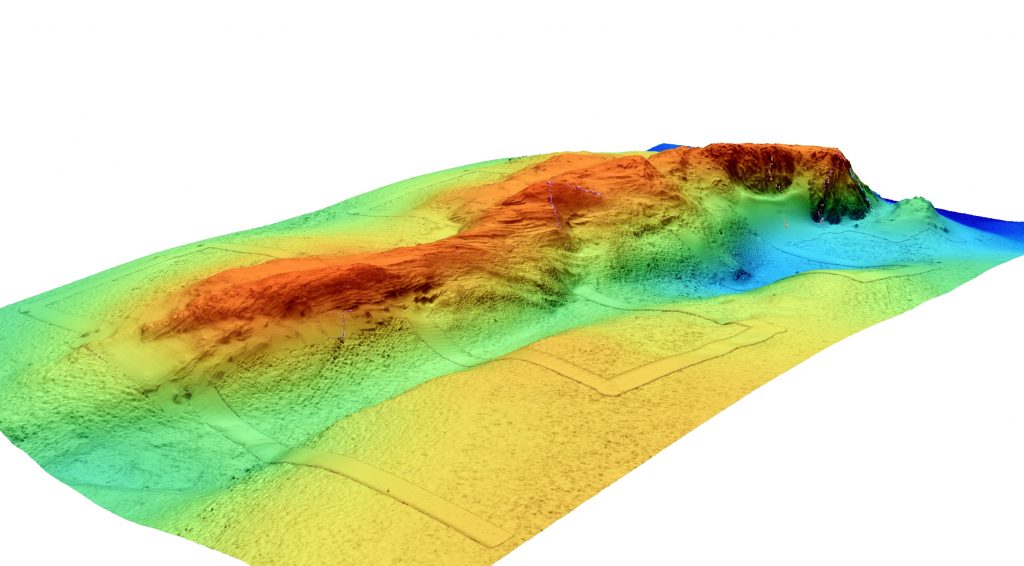
One long 12-hour dive was conducted today in the northern section of Sur Ridge. The corals and sponges seem to be more plentiful here, and it’s also where MBARI placed several transplanted corals, which was our first stop. The purpose for this coral transplantation pilot experiment is to begin to explore viable methods for restoring corals in areas that may be decimated by a future event, be it oceanographic or physical in nature. MBARI transplanted these corals more than 12 weeks ago, and to the team’s delight, many of the transplanted bamboo corals were not only alive, but appeared to be very healthy with their polyps out. This is a positive sign, and over the next two days, we will see how the other transplant clusters have fared.
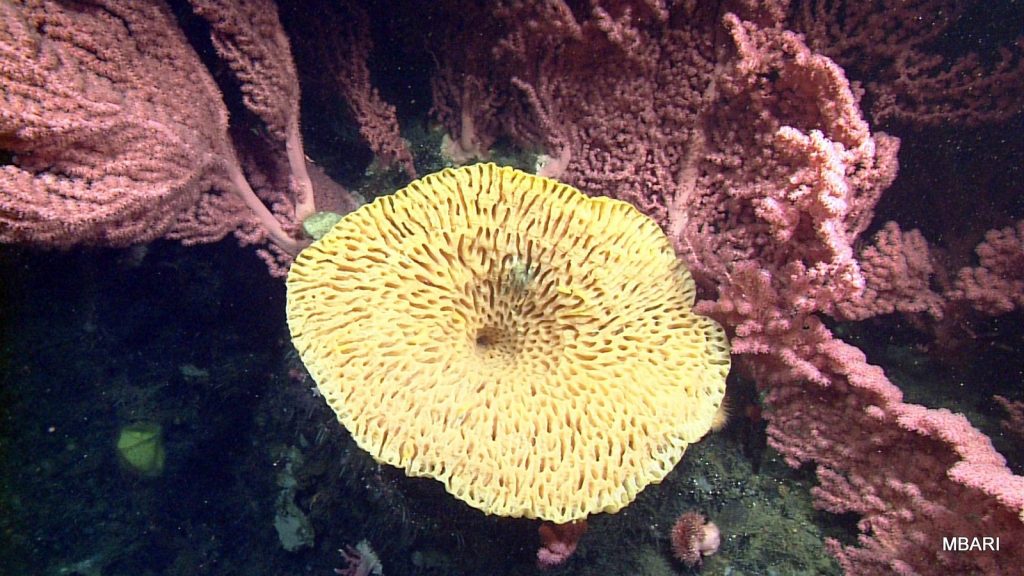
For most of the day, the science crew observed particle flow with green fluorescent dye that surrounded creatures in a somewhat magical glow. For sponges, the green dye was ejected from a tube up-current from the outside of the animal. Although it would generally take more than 30 seconds, we would begin to see the green dye pass through the sponge (through many holes, called ostia) and out the top, or osculum. At that point, the dye was turned off, but it continued to escape for a period of minutes.
Throughout the dive, various organisms were collected for analyses of their carbon/nitrogen ratios. After the ROV surfaced, the science crew worked together to identify and preserve each specimen. Josh Lord, PhD (MBARI), noticed one of the bamboo corals bioluminesced (blue) when he disturbed it in a bucket of water. Although we handled many of these species back in June during transplantation, no one witnessed this phenomenon, most likely due to the brighter lights of the moon-pool area. Bioluminescence in the deep is very common, but it’s not immediately known why this species of bamboo coral exhibits this trait, but it has been witnessed before in deep-sea corals.
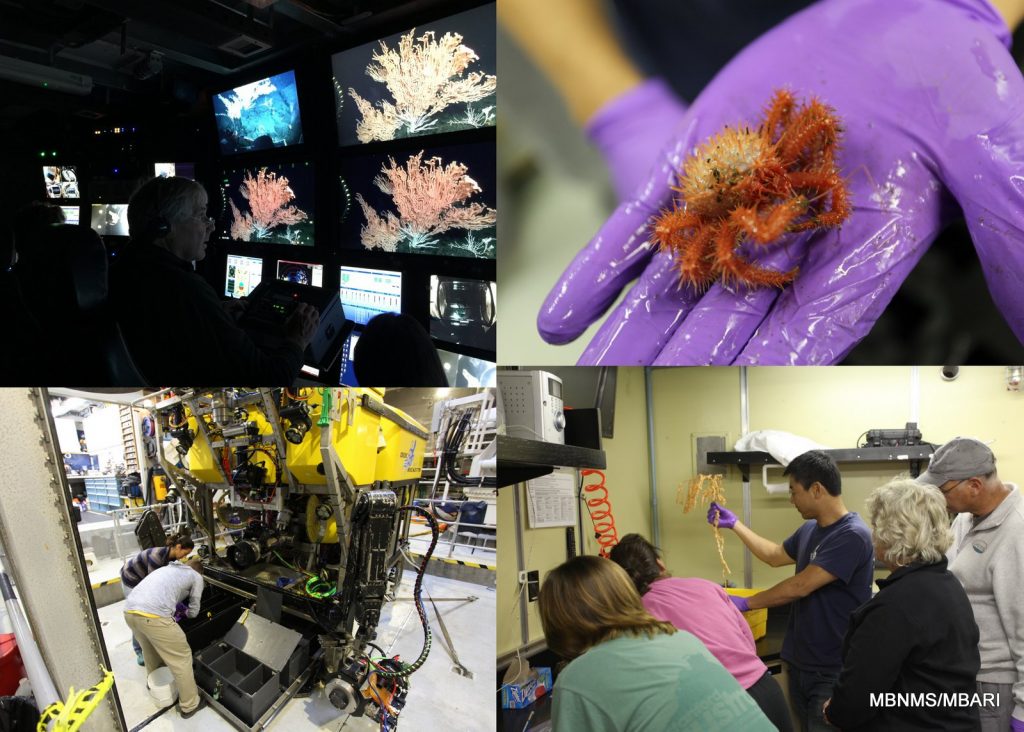
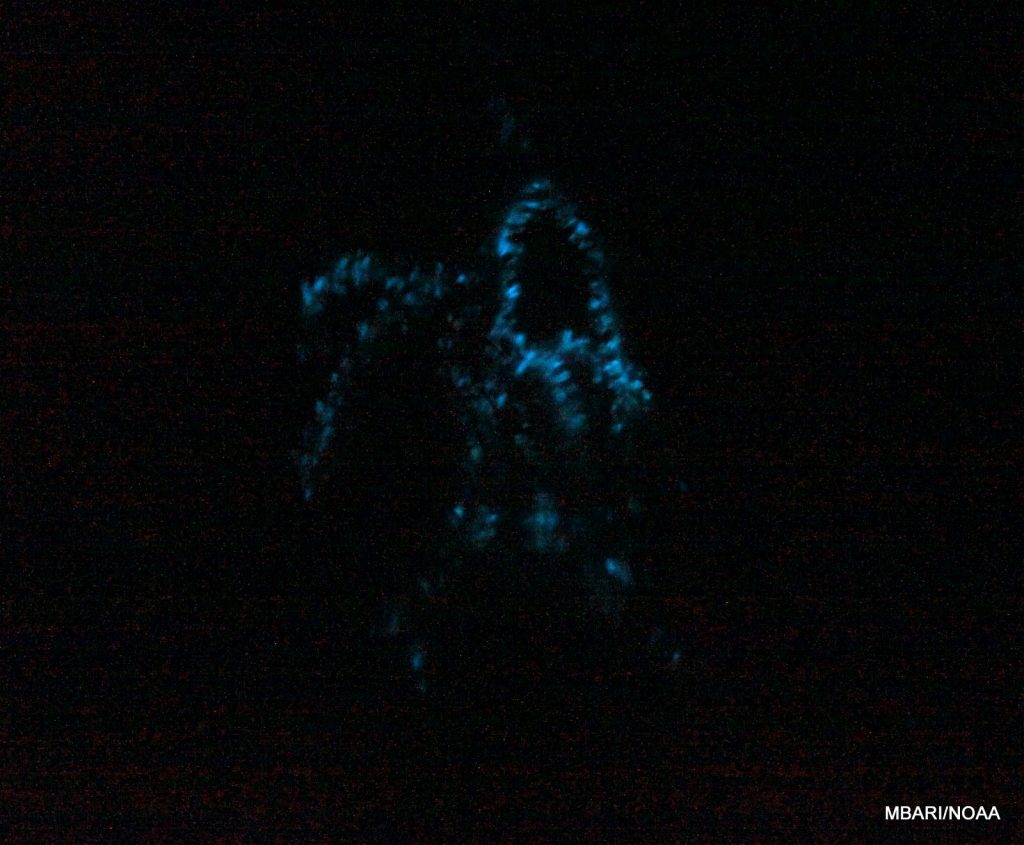
Tomorrow will be our last full day of diving, but we hope to report to you a few more interesting observations before we return Sunday evening.
Chad
Aug 25 – Day 2
Today’s dive was the deepest of the expedition. Miles offshore from Monterey Bay lies an experiment placed by Dr. Jim Barry in March 2009 at a depth of 3,209 meters, which is just shy of 2 miles (1.993 miles, to be precise). That’s taller than seven Empire State Buildings! The ROV’s descent takes a couple of hours just to reach that depth.
The experimental unit is a four foot by four foot by eight foot corn bale made from corn “stover,” or the stalks, leaves and cobbs left over from the corn harvest. Dr. Barry directed the pilots to collect galitheid crabs, or squat lobsters that were living on the bale (presumably using the corn bale as food), and a second collection of crabs at a distance of 100 meters, which act as a control. MBARI will analyze stable carbon and nitrogen isotopes in muscle tissue from the crabs to help understand just how much energy these animals may be getting from the corn bale, compared to the normal deep-sea food sources.
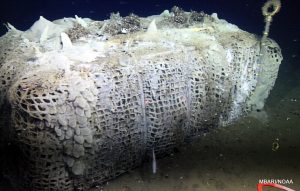
The assumed bacterial mat seen during previous visits to the bale had multiplied more than 10 fold, producing an appearance of light white foam atop your morning latte. We collected some of that material for analyses, because we truly don’t know if it’s microbial in origin or something else. Samples were taken from the inside of the bale with the use of long PVC pipes that cored the inside of the bale. These samples will be analyzed for microbial presence, since the inside of the bale is generally devoid of oxygen. Several video transects of the seafloor were run throughout the day.

The day concluded by testing water uptake and filtration by sponges and a tunicate with fluorescent dye.
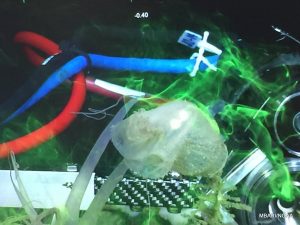
Probably the most curious sighting of the day was that of an old sink that was probably discarded from a passing ship many years ago. Even way out here, the deep sea can reveal the trash of ocean-goers past.
Over the next three days we will revisit the colorful sponge and coral gardens of Sur Ridge. We will also revisit coral transplantation experiments to see how they are coming along, and measure marked corals to determine growth rates.
Chad
Aug 24 – Day 1
The moon dictated our departure time of 7:30 am, due to the fact that the Western Flyer cannot leave nor return to Moss Landing harbor, unless it is near high tide and there is enough draft in the main channel for the ship to safely pass. Calm seas, humpback whales, and sea lions greeted our departure, but our first stop was within Monterey Bay and we arrived on station within an hour, and prepared to launch the remotely-operated vehicle, “Doc Ricketts.”
Previous expeditions have taken us to a lost shipping container, where we have taken video of the biological growth all over the container and sampled organisms and sediments near the container to see if any of the toxic paint, in which the container is coated in, is affecting the local fauna and sediment. In November 2014, the Sanctuary and MBARI worked together to construct five replicates of four treatments of material that were placed at a depth of 200 meters (much shallower than the shipping container, by the way) for purposes of observing differences of biological settlement and growth on differing surfaces. Two treatments consisted of shipping container metal coated in two different types of anti-fouling paint. One paint is considered toxic, the other “green.” The other two replicates were blocks made of sandstone and granite to simulate natural substrate. While at this site, MBARI scientists also conducted some water flow experiments with sponges in the area.
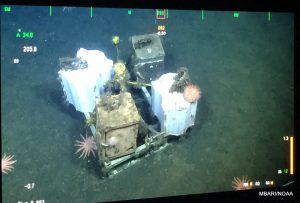
After a satisfying lunch, we pulled the ROV and proceeded to the next station at the outskirts of Monterey Bay. In 1982, the barge “Umpqua II” grounded near Moss Landing before being towed out to sea and sunk. MBARI re-discovered this wreck by accident several years ago. Through the murk at 1,660 meters below the ocean surface, we come across the starboard side of the 80 meter long vessel. Draft markings indicated at least that portion of the hull was buried at least one meter into the ocean floor sediments. It was also clear that a significant portion of the starboard aft side of the ship and deck ripped off at some point, as portions from this part of the ship were completely missing. Scallops, crabs, polychaete worms, Neptunea snails, assortments of cnidarians and other biota covered the barge, but its name was completely visible on both sides of the bow as well as the rear of the ship. After some biological and sediment samples were taken, the ROV ascended during dinner, followed by the preservation of samples.
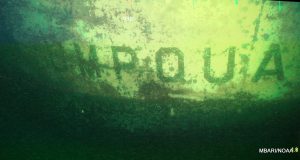
Tomorrow we will visit a long-term experiment that sits more than two miles below the surface! At least that long descent will give us time for a leisurely breakfast and maybe even two cups of coffee before hitting bottom.
Chad